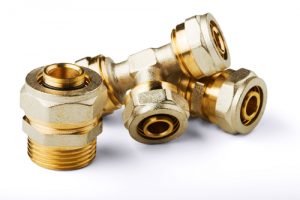How to Use Plumbing Compression Fittings for Some Easy Plumbing Fixes
Date: January 25, 2019
PLUMBING COMPRESSION FITTINGS ARE KEY TO DIY PLUMBING INSTALLS
What is a plumbing compression fitting? These little knob-like fixtures (pictured below) connect pipes securely. Even in cases where two pipes may be of slightly different sizes, plumbing compression fitting allows for secure pipe connections so that water doesn’t leak. Especially if you are pursuing a DIY plumbing install, knowing the difference between plumbing compression fittings vs solder fittings (sweat fittings) and why you may need them both in your DIY plumbing tools basket can configure how you pursue your new plumbing installs or DIY plumbing fixes.
While the idea behind plumbing compression fittings may be simple enough, nothing’s ever really that simple? Some things you need to consider before purchasing your plumbing compression fitting is the size of the fitting and material. If you’re dealing with underground metal pipes, you would clearly want to use metal plumbing compression fittings. Conversely, if you have plastic or PVC pipes, using a fitting of a similar material ensures that you don’t break anything along the compression plumbing fittings install.
Necessary DIY Plumbing Tools
One of the major benefits to compression plumbing fittings install is that the purpose of a compression fitting, as opposed to alternatives, is its ease of use. This will especially become true in the section on compression fittings vs soldering. As such the DIY plumbing tools necessary are rather minimal. Besides the obvious pipes, the compress fitting will comprise of the compression nut, the compression ring, and the compression seat (the actual fitting). For the compression plumbing fittings install, you will simply add both the nut and the compression ring onto the pipe (place the compression nut first). After connecting the pipe and the fitting together (and of course depending on the size of the pipe and fitting), use tongue and groove pliers or small adjustable wrenches to tighten the plumbing compression fitting to the correct seal tightness. You could alternatively use your hands and fingers although (again depending on the size and material), you may risk harming yourself or not accurately tightening it correctly. We recommend using DIY plumbing tools for tightening as they’re more accurate, safe, and easy-to-use.
Compression Fittings VS Solder (Sweat Fitting)
Sweat fitting or soldering requires heat meaning you will need to consider heating and cooling time. As a result, it may take a much longer time, especially if you’re attempting to compound or compile many pipes at various joints. Additionally, the material required in Soldering is more expensive as it will require a blowtorch and is extremely labor-intensive compared to its compression fitting counterpart. That is the major difference between plumbing compression fittings vs soldering. In fact, if soldering is an option you want to consider, we highly recommend you schedule a consultation with your local plumber to discuss the precision needed for the pipework. Especially if you’re looking to pursue compression fittings, this is the option you should be pursuing.
Common Compression Plumbing Fittings Install Problems
While the installation process can seem tricky at first, the actual process can prove to be rather simple and speedy. With that said, here are some issues you may encounter and how to avoid them altogether.
Tightening Pipes Too Hard.
Our gut feeling during the compression plumbing fittings install is to tighten the plumbing compression fittings tight enough so that water doesn’t leak. And indeed it would make sense that tightening the knots would prevent leaks; however, by tightening too hard, there’s a chance of risking inside ring damage. These rings are the component of the compression fittings that allow for the compression between pipes and when sustaining damage, they may be unable to do their jobs. So, when tightening pipes through compression fitting, do so by ensuring pipes are sturdy and connected but that pipes and fittings that do not belong together aren’t put together. By that, we mean turn until you start to feel resistance and then go AT MAX only a half turn more.
Multi-Use Error.
The compression fittings for your DIY installations are able to be used multiple times. However, the rings are meant for one-use only and are stationary. So if you want to move pipes around the house, you will need to buy a new compression ring because it won’t compress in the same way as before. As for the compression fittings, note that they are each designed for specific pipe sizes so don’t try to over-exert compression fittings. Use them for similar (if not the same few) pipe sizes.
Not Lubricating The Compression Nut Threads.
Be sure that during the compression plumbing fittings install process, you lubricate the ring and the nut threads. Lubricating will increase the success rate of securely connecting plumbing pipes throughout the house. As a result, you’ll be able to securely tighten with the compression fitting to your liking.
Pairing Different Material Tubes With Fittings.
As mentioned earlier, plastic pipes and metal fittings simple won’t work. Or at the very least, they carry a risk of breaking during the installation process. Especially as different levels of pressure are needed between plastic fittings and metal ones, pairing the correct material together is vital for proper installations.
In Summary,
The plumbing compression fitting is a great way to easily and securely connect plumbing pipes throughout your house. With the DIY plumbing tools being pretty minimal, the plumbing compression fitting is a relatively economical option to employ throughout your house compared to its alternative counterparts. There are instances, however, that may be more intensive, especially if you’re attempting to align pipes within walls that are not easily accessible. If you still have questions regarding plumbing compression fitting, whether it be best DIY practices, or simply for help with the entire process, feel free to reach out to us our comfort heroes will be more than happy to assist you in the installation process.

